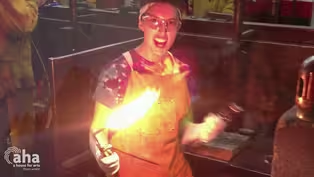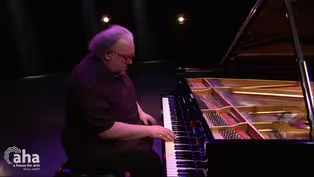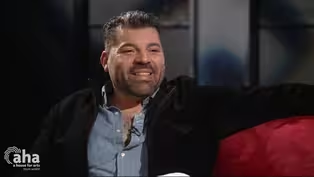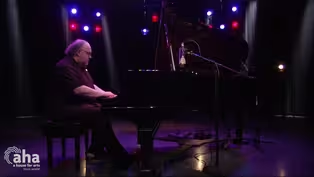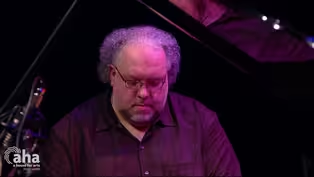
AHA! | 830
Season 8 Episode 30 | 28m 45sVideo has Closed Captions
Join us as we delve into the vibrant art scene of NY, from metal sculpture to music.
Meet the masterful Tori Rodriguez who breathes life into metal in her Troy, NY studio. Oscar Alberto Bogran, a gifted multidisciplinary artist from Schenectady, shares about the rejuvenation of the city's art scene with Gallery 5. To top it all, we have composer and pianist Andy Iorio performing 'Solace' from his 2019 album 'Awakening'.
Problems playing video? | Closed Captioning Feedback
Problems playing video? | Closed Captioning Feedback
AHA! A House for Arts is a local public television program presented by WMHT
Support provided by the New York State Council on the Arts (NYSCA), M&T Bank, the Leo Cox Beach Philanthropic Foundation, and is also provided by contributors to the WMHT Venture...

AHA! | 830
Season 8 Episode 30 | 28m 45sVideo has Closed Captions
Meet the masterful Tori Rodriguez who breathes life into metal in her Troy, NY studio. Oscar Alberto Bogran, a gifted multidisciplinary artist from Schenectady, shares about the rejuvenation of the city's art scene with Gallery 5. To top it all, we have composer and pianist Andy Iorio performing 'Solace' from his 2019 album 'Awakening'.
Problems playing video? | Closed Captioning Feedback
How to Watch AHA! A House for Arts
AHA! A House for Arts is available to stream on pbs.org and the free PBS App, available on iPhone, Apple TV, Android TV, Android smartphones, Amazon Fire TV, Amazon Fire Tablet, Roku, Samsung Smart TV, and Vizio.
Providing Support for PBS.org
Learn Moreabout PBS online sponsorship(upbeat jingle) (calm music) - Sparks fly in the studio of sculptor Tori Rodriguez.
Chat with muralist Oscar Alberto Bogran.
And catch a performance from Andy Iorio.
It's all ahead of this episode of AHA!
A House for Arts.
- [Narrator] Funding for AHA has been provided by your contribution and by contributions to the WMHT venture fund.
Contributors include The Leo Cox Beach Philanthropic Foundation, Chet and Karen Opalka, Robert and Doris Fischer Malesardi, and The Robison Family Foundation.
- At M&T Bank, we understand that the vitality of our communities is crucial to our continued success.
That's why we take an active role in our community.
M&T Bank is pleased to support WMHT programming that highlights the arts, and we invite you to do the same.
(calm music) (energetic music) - Hi, I'm Jade Warrick, and this is AHA!
A House for Arts, a place for all things creative.
Here's Matt Rogowicz with today's studio visit.
(funky music) - I'm here in Troy, New York, about to step inside the studio of artist Tori Rodriguez.
Follow me.
- I'm a multimedia artist, primarily working in metal sculpture and also fine art painting.
(funky music) The first time I welded was in high school and completely fell in love with it, but didn't think that that's what I wanted to do like as a career.
As I started to get more into my art in my 20s, at the same time, I was working in manufacturing, doing like programming and design work for a company that does all precision cutting.
So I got a lot of exposure to different materials, steel, aluminum, stainless, some specialty alloys.
Initially went to school for interior design, took some time off of college for a few years, and then went back to school full-time for welding.
And that really pushed me to get more into metal sculpture.
I just really love steel, it's very versatile.
You can use steel for building large structures, for building smaller things.
There are different finishes that you can put on it, I love texture, I have like a whole thing about texture, so playing with the different finishes and patinas and treatments on steel, I find that to be a lot of fun.
(eerie music) The Mastodon in Cohoes, New York, that was my first large-scale piece that I did.
I worked with the Abram Lansing Elementary School, the principal of the school, and I sat on an art committee together, that's how we met, and then he had this idea to have me come in and talk to the students.
So I got sketches from a bunch of third graders of what they wanted this giant sculpture to look like.
Put them in a pile, see what the popular vote was, see what was buildable.
And that's how the sculpture kind of came to be.
I built a frame out of one-inch steel tubing and then the rest of it is entirely out of scrap.
I had no idea what I was getting into, but I'm pretty happy with it.
Have you seen the owl?
(triumphant music) The owl is at Okte Elementary and that's in Clifton Park.
The art teacher at Okte Elementary, her kids play soccer in the field where Mastodon is.
So she saw that and she was like, "I need a sculpture like this."
So I got linked up with her and she was like, "You know, could you build something like this for us?"
And I said, "I can, but my stipulation is that I get to come in and talk to your students about how cool welding is."
We're seeing such a shortage of welders in the industry right now that companies are just, they're hurting.
A lot of them are forced to move toward automation because they can't fill positions.
And there's just like not as many people coming into the industry as the people who are coming out of the industry, so in a world of social media influencers, how do you try to inspire the next generation to wanna do something to work with their hands, to do something that's really an essential skill?
I mean, welding is used in so many industries.
So that's part of why I go in to talk to students and work with them.
You know, the art part is very cool, but it really, you know, I have a dual purpose of being there and trying to inspire the next generation to still wanna stick with the trades.
(upbeat music) So I've done plenty of small-scale sculptures.
I like the idea of doing something that's functional but also artistic.
A couple years ago, I was walking through my house looking for some drinking glasses, I was having people over and I'm like, where did all my drinking glasses disappear to?
And they were scattered throughout my house holding plant clippings.
So I was like, okay, I'm a fabricator, I'm an artist, it's time to make something cool.
That's when I started making propagation stations.
I love the juxtaposition of like the heavy industrial, almost post-apocalyptic design of these, with the delicacy of the glass in the plant.
I also am finishing a new prototype design for a banana stand that goes in your kitchen that's in the shape of a scorpion.
(jazz music) The large scale project on deck is going to be a suspended sculpture coming out of a skylight in downtown Albany.
It's going to be in a restaurant, I can't tell you who it's for yet, but they have a very like Louisiana, New Orleans vibe.
And they asked me to build us out of old instruments to kind of bring that jazz feel into the space.
The instruments for this project were donated by Cole's Woodwind Shop up in Saratoga Springs.
They're older and a lot of them have been decommissioned.
My plan is to have a music case open on like the upper backside of the sculpture and then have it, like all of the instruments look like they're falling out of it, almost like a Mary Poppins kind of feel, like very whimsical.
The instruments that are gonna be like closer to the case, I wanna put a stronger patina on those to make them look older, and as they come into the space, kind of fade out that patina and, you know, polish them and make them look newer.
My brain just has so many ideas that I'll probably die before I just can physically get to all of them.
So I like to take on projects that are gonna push me to do something better and bigger.
- Oscar Alberto Bogran is a multidisciplinary artist living in Schenectady.
Through murals, installations, performance arts, and more, Oscar strives to create a positive impact in his community.
I sat down with Oscar to learn more.
Hey, Oscar, welcome to A House for Arts today.
- I'm happy to be here.
- Yeah, me too.
- So excited.
- So to begin, on a first ask, like why do you brand yourself as an artist, like how do you see yourself as an artist, who do you perceive yourself to be?
- I guess, I mean, branding kind of makes me uncomfortable.
Like to be labeled or branded just really doesn't sit well with me, I guess.
So I consider myself like a multidisciplinary and I'm a huge fan of like conceptual art because of that, because there's really no box, you know, there's no like, 'cause, you know, if you're a painter, you have to paint.
If you're a sculptor, you sculpt, it's like there's always limitations.
And I think as an artist, for me personally, it kind of like rubs me the wrong way to be labeled.
So if people ask me and I just say I'm multidisciplinary, so I dabble in a lot of different things.
- Well, what are some of those things?
And I understand that it is hard to put an artist in a box, right, 'cause we can like spread throughout so many things, it's so fluid, it's so accessible.
- Well, with me personally, painting has always been like something that I grew up doing, right?
Drawing, painting, a sculptor also, like especially with wood and metal, pretty much anything that I can relay a message with.
It doesn't necessarily have to be traditional media.
It could be my body, you know, like performance art.
I've done some performance art pieces in Boston.
One in particular that I really like, resonates with me is the Immigrant Does Not Equal Criminal project I did in Boston where I welded a cage and I sat in that cage for a whole day in different locations in Boston.
That was, you know, an example of nontraditional medium, you know, that I love, and I feel like it just, it goes against the grain, you know?
And it rubs people the wrong way, and then some people are just like, whoa, what is this, you know?
I got a lot of weird looks, you know, especially like, I was in the Boston Common and there was like a field trip happening at the same time.
So here's this Latin guy in this little cage and all these little kids are like trying to like figure out what's going on.
And you see the teachers like, get away from the weirdo, guys.
- Oh my God.
- You know, so it was so, it's good, like I love that, right, I love to tell stories and I think that there shouldn't be limitations on how to do that.
- So you like the reaction piece to it too, huh?
- Yeah, yeah, it's just like, yeah, if it doesn't leave an impression, then like, did you really do it?
- Yeah, like a tree falls in woods- - Does it really exist?
- Yeah.
I know you're in graffiti and things a little bit too, right?
- Yeah, I grew up, well, yeah, so when we first moved from Honduras, that's where I'm from, I was about seven years old, and we moved to Brooklyn, and the first thing I saw was graffiti art.
Like the trains covered, like, this is like early 80s.
So, you know, hip-hop was forming, like this new like way of thinking was existing that I never knew about.
And when I was exposed to it, I was like, you know, like seeing a cathedral for the first time, it was like, oh, like this godly presence.
And you see these graffiti artists hanging off bridges with belts, you know, and like, I wanna be like that.
Like they were like my superheroes, like they'd be in the sewers, they'd be like in the middle of the night in the abandoned buildings and it, yeah, that really, like I really, it drew me in, you know, it sucked me right in.
So hip-hop, graffiti, you know, I started writing too, like, you know, rapping, doing battle raps- - Everything.
- Everything, like, 'cause I always wanted, like I never stopped learning, I like crave to learn new things, it's just like something that's embedded in me.
I think that's why I decided to go into higher ed, you know, 'cause just learning has always been something I love.
- Yeah, something attractive.
- Yeah.
- So how has that journey, from starting from Brooklyn, you know, did that influence you, you already said the graffiti's influenced you, has anything else from your time and your past influenced who you are?
- I guess just going through a lot of downs, you know, hitting rock bottom, like being homeless at times.
Not having a lot of support as far as, you know, my family is very traditional.
You know, we're an immigrant family.
I remember my father constantly like telling me, "You're not gonna be an artist.
That's not a real job.
Like we basically risked our lives to get to this country, you're not gonna throw it away," you know, and I was just like, okay.
But deep down inside, I'm like, I'm gonna be an artist, like I have to.
So I think the struggle is what made me who I am and going through that struggle, and that's why like I think I'm good with the education piece too, like I see young artists coming up.
And the first thing I hear is like, "It's so hard, it's so hard."
Embrace that.
It's gonna make you who you are.
Like these struggles, this hurt, use that, right, it's like that's our superpower.
We're hypersensitive beings as artists, and using that is what makes the best art, I think.
- Yeah, and how do you use that?
- So yeah, I try to talk about my struggles and my pains through my art.
Whether it's through the paintings I do, the performances, the sculptures, it talks about me, personal.
Like the murals I've done are very personal, they have people, they show people that are personally involved in my life, that had effect in my life.
So I'm just using everything I can possibly feel and try to show people what that feels like.
- Yeah, do you think that's the theme of most of your work reflects on your, like your history, your feelings, your emotions?
- Yeah, definitely, 'cause I feel like that's, it's my outlet, it's my therapy.
Like I need to express a lot of things.
And a lot of times, we can't, right, because it's very personal.
It makes people uncomfortable, nobody wants to hear about your personal stuff.
So I just, let's put it on a wall instead or in a sculpture or in a performance, you know, and it's more acceptable, I guess, more digestible that way.
- That's interesting that it is more digestible to see it in art form versus like to sit face-to-face, have a conversation, people are like, I don't know about that, but you create a mural about it, people are like, oh, I understand, I get it.
- Right.
- So you work a lot in education, can you give us a little bit of background of that, like what do you do- - Yeah, well, I'm currently an adjunct at SUNY SCCC, SUNY Schenectady, and I teach art history there.
And I think a lot of the students that I see come from really like hard backgrounds, you know, struggling, you know, financially and maybe a lot of family issues.
And so I think they tend to gravitate towards me and my classes get filled up every semester, and you can tell they don't even like art history but like, they love the fact that they can come to a space and feel safe and express themselves.
You know, 'cause I mean, that's what art's all about.
So I embed that into my lectures, you know, 'cause history can be boring, but if you can find a way that it relates to you, then all of a sudden, it becomes interesting.
And so I make it very relatable.
- Well, how do you get them to engage, like what are your techniques?
- I talk a lot about the artists' personal life and like who the artists were, like why they were who they were.
And then like I try to put it in context for the student, like who would, you know, van Gogh be today?
You know, what would he be considered today?
Maybe he'd be in a mental health institution, you know what I mean, like stuff like that, like very relatable, like, you know, and just trying to find connections for them.
- I think Pollock's a good example, I think people look at his stuff, they're like, oh, that's just splattered paintings, I don't understand it.
But if you know Pollock the artist, it changes your perspective on every single piece that he's done so far.
- Yeah, yeah, he was a man that- - Thank you for that.
- He was a man that went through struggle, Pollock- - He's had a lot of struggles, yeah, good, bad.
He's kind of a good guy, kind of a bad guy, lots of mixtures in between.
So I heard there's a little gallery called Gallery 5 in Schenectady and I wanted to hear a little bit about that, like what's your role in it and what is it?
- So I'm one of the founding members of Gallery 5, and it's really a collective of about eight people in Schenectady, and it all started with just networking.
We would go, you know, I would, I'm always big on networking and going to events and supporting other artists and other art events.
And I started seeing the same people at these events.
The conversation always came up like, how do we get more fine arts in the Schenectady area?
And I just kept saying the same thing, we need a fine arts gallery.
And I'm not just talking like a little mom and pop gallery, we need, you know, like a MOCA or a MoMA, you know, something that's really high-end, high brow, you know, just quality work.
And I know that's debatable, what quality work is but, you know, we had artists, for this past show that just happened, we had artists that were selling at $40,000.
- [Jade] Wow.
- And then we had artists that sold at $100, right?
But having a place where high-end artists can come and show I think creates some sort of like an atmosphere of professionalism and artists want to show there.
- [Jade] Yes.
- Right, so we had about 800 to 900 people in attendance and thousands of dollars sold in artwork.
- [Jade] That's amazing for your first opening.
- I mean, the first night, it was about $13,000 worth of art sales.
- [Jade] Wow.
- So it's possible.
Getting the right people involved seems to get things going and making things happen.
So yeah, so Gallery 5 had our first show and now we're planning on having a second one in the fall, like in October-November.
So look out for that.
- That's gonna be nice, now, why do you think that you already, you mentioned how this is important for artists, but what about for Schenectady?
Like do you think it's just important for Schenectady to have this art place so artists from all over can utilize this as a hub, as an important space for- - Yeah, I mean, definitely, it's gonna be a hub.
So the goal, I guess, of Gallery 5 is to eventually have a permanent home, right?
And not just popups, like we're doing these popups now as a way to kind of raise funds, but the goal is to have a permanent home.
And having a permanent home would mean maybe residencies, you know, maybe event space for the community, and definitely fine artwork and having like a permanent collection, right?
Who's to say we can't have a van Gogh or a real van Gogh, you know, or a Picasso hanging in this Gallery 5, you know?
So I mean, it's something that I think Schenectady really needs, Capital Region in general.
- Definitely does, well, thank you for providing that space, and I'm looking forward to coming to the fall show.
- [Oscar] Yeah, please.
- And thank you for giving us a little bit of background on who Oscar the artist is.
- Appreciate you.
- Appreciate you.
Please welcome Andy Iorio.
- [Speaker] Okay.
(piano music) (calm music) - Thanks for joining us.
For more art, visit wmht.org/aha, and be sure to connect with us on social.
I'm Jade Warrick and thanks for watching.
- Funding for AHA has been provided by your contribution and by contributions to the WMHT venture fund.
Contributors include The Leo Cox Beach Philanthropic Foundation, Chet and Karen Opalka, Robert and Doris Fischer Malesardi, and The Robison Family Foundation.
- At M&T Bank, we understand that the vitality of our communities is crucial to our continued success.
That's why we take an active role in our community.
M&T Bank is pleased to support WMHT programming that highlights the arts, and we invite you to do the same.
In the Studio with Tori Rodriguez: Reinventing Metal Art
Video has Closed Captions
Clip: S8 Ep30 | 5m 28s | Explore Tori Rodriguez's journey from welding in school to inspiring future generations. (5m 28s)
'Passage' by Composer Andy Iorio
Video has Closed Captions
Clip: S8 Ep30 | 3m 13s | Experience the captivating performance of 'Passage' by Andy Iorio. (3m 13s)
Reinventing Schenectady: Art Renaissance with Gallery 5
Video has Closed Captions
Clip: S8 Ep30 | 10m 21s | Oscar Alberto Bogran shares his journey of artistic self-expression in Schenectady. (10m 21s)
'Reverie' by Composer Andy Iorio
Video has Closed Captions
Clip: S8 Ep30 | 3m 43s | Experience the captivating performance of 'Reverie' by Andy Iorio. (3m 43s)
'Solace' by Composer Andy Iorio
Video has Closed Captions
Clip: S8 Ep30 | 3m 1s | Experience composer Andy Iorio's moving performance of "Solace". (3m 1s)
Providing Support for PBS.org
Learn Moreabout PBS online sponsorship

- Arts and Music

Innovative musicians from every genre perform live in the longest-running music series.












Support for PBS provided by:
AHA! A House for Arts is a local public television program presented by WMHT
Support provided by the New York State Council on the Arts (NYSCA), M&T Bank, the Leo Cox Beach Philanthropic Foundation, and is also provided by contributors to the WMHT Venture...
